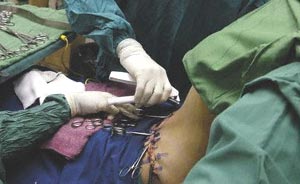Abdominal Liposuction

Fat on the abdomen is one of the woes of most women seeking to get into better shape. Many a time, abdominal liposuction is resorted to - a process whereby subcutaneous fatty deposit is removed from the abdominal area. The neck is one area where we tend to accumulate fat as we age. You can streamline the neck contour and improve your profile too. Neck liposuction can help in sculpting a turkey neck that has excess fat and thereby improve your appearance. We take a look at various alternatives to liposuction.
Abdominal Liposuction
The abdomen is one of the most frequently treated body parts for liposuction. This surgical procedure is used for removal of fat deposits from the abdomen. Abdominal fat can be either subcutaneous (lying under the skin) or intra-abdominal (located internally near the intestinal loops). Abdominal liposuction works to remove abdominal subcutaneous fat. Abdominal fat deposits can be extremely resistant to diet and exercise.
Consequently this area is subjected to surgical intervention to get rid of the fat around the waistline. A typical abdominal liposuction procedure may take one to two hours of surgery. An incision is made in the skin below the navel and thin tubes (cannulas) are inserted into the fatty deposits. They are used to break up the deposits of fats and achieve a sculpted look. The fat is sucked out with a powerful vacuum, without affecting the skin, muscles, nerves and blood vessels. Tumescent liposuction is used more often for this type of liposuction surgery. Abdominal liposuction is sometimes accompanied by a tummy tuck (abdominoplasty), wherein a large excision of skin is also performed. Lax abdominal muscles are tightened with this procedure.
Neck liposuction
Liposuction of the neck is performed to significantly improve the contour of the neck and the procedure is useful for patients with good skin tone who have excess fat beneath the skin. Neck liposuction alone takes about 30 minutes to perform. In this process, tiny skin entrance wounds are made with a scalpel just under the chin and just in front of the ears. Then the excess fat is removed in a spoke wheel pattern and the vacuum is turned on to suck out whatever fat will come.
This type of liposuction needs to be carefully performed so as to prevent damage to the undersurface of the skin and the basic structure that includes the laryngeal cartilage (Adam's apple), the hyoid bone, the tongue muscle and the platysma muscle (sheet-like muscle) and the fat which lies between the platysma and the skin. Small instruments are connected to the suction to remove the fat, carefully and aesthetically. This liposuction procedure is often combined with other plastic surgery procedures. The recovery process is fast and stitches are removed within 3 days.
Liposuction recovery
Earlier, recovery after a liposuction surgery would take weeks or even months, of painful healing and limited mobility. But with the advent of new techniques, liposuction recovery is much quicker and less painful. Often patients return to work within hours or few days. Liposuction recovery process is as important as the procedure itself and it is imperative that the patient follows the advice of the liposuction surgeons.
Recovery after a liposuction process depends on the surgical technique that has been used. Recovery from tumescent liposuction involves a compression garment that is worn in addition to the pads placed over the incision areas. The compression garment plays an important role in the recovery process as it allows use of absorptive pads beneath and can be easily taken off. During liposuction recovery, patients must monitor their incision points and watch closely for infection. If infection occurs during liposuction recovery, it can be fatal.
Tips for a speedier recovery after a liposuction surgery:
Non-surgical liposuction
There are alternatives to liposuction that do not involve surgical procedure. Exercising and good diet can go a long way in decreasing body fat and maintaining good body composition. Non-surgical liposuction includes specially formulated gels that penetrate into the skin and cause dissolving of fat. This liquefied fat is then channeled into normal body excretion modes. Sea wraps offer yet another liposuction alternative as they can help in compression the cells and making the skin lose water. But many of these alternatives to liposuction are not approved medical treatments under the FDA.
Top of the Page: Abdominal Liposuction
Tags:#Liposuction alternative #Non surgical liposuction #Neck liposuction #Liposuction recovery #abdominal liposuction
 Beauty
Beauty Cosmetic Surgery
Face
Cheek Implants
Mini Facelift
Non Surgical Face Lift
Eyebrow Transplantation
Cosmetic Eye Surgery
Ear Plastic Surgery
Rhinoplasty
Chin Liposuction
Cosmetic Dentistry
Facial Cosmetic Surgery
Chin Surgery
Reconstructive Facial Surgery
Body
Sublative Rejuvenation
Lower Body Lift
Anti-ageing Cosmetics
Wart Removal
Mole Removal
Breast Augmentation
Liposuction
Liposuction Surgery
Cosmetic Laser Surgery
Spider Vein Laser Surgery
Abdominal Liposuction
Umbilicoplasty Surgery
Plasma Skin Resurfacing
Skin Tag Removal
Top of the Page: Abdominal Liposuction
Popularity Index: 100,892

